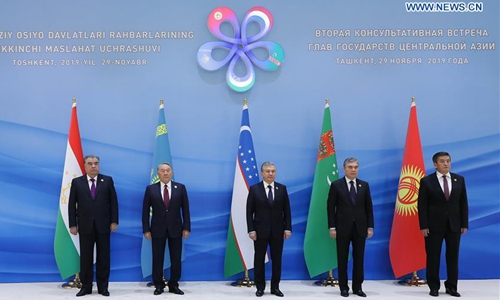HOME >> OPINION
Trump’s Central Asian strategy should seek major power cooperation, not conflict
By Xiao Bin Source:Global Times Published: 2019/12/29 21:24:57

Leaders of Tajikistan, Kazakhstan, Uzbekistan, Turkmenistan and Kyrgyzstan (from L to R) pose for a group photograph before the second consultative meeting of the heads of state of the Central Asian countries in Tashkent, capital of Uzbekistan, on Nov. 29, 2019. Leaders of the five Central Asian states on Friday agreed to enhance cooperation in areas of trade, industry, energy and transportation, Uzbek president's press service said. Photo: Xinhua/Zafar Khalilov
During a press briefing following Kazakhstan's Foreign Minister Mukhtar Tleuberdi's meeting in Washington, a US State Department spokesperson announced on December 13 that the Trump administration would unveil its new Central Asia strategy.
There have been five US presidents since Central Asian countries gained their independence. Before the 9/11 attacks, Washington didn't give much attention to its Central Asia strategy. Based on combining US national interests with international political realities in the region, the US shifted its "Great Central Asia" plan to the "New Silk Road" initiative, through which it has exerted great influence on those countries while safeguarding national interests.
Despite its geopolitical value, Central Asia has remained marginalized in international politics. In the multipolar era, the power struggle between the British and Russian Empires in the 19th century was known as "The Great Game."
In the bipolar era, the Soviet Union was the sole dominant power in Central Asia, while in the unipolar world, Russia sits at the top of the region's power landscape, while US and Chinese influences emerge.
After Donald Trump took office, he didn't change the Central Asia policy of his predecessors. However, since 2018, what Trump has done in the region has sent a strong signal of adjustment.
The US president appointed new ambassadors to the Central Asian countries, consolidated "strategic partnerships" with Kazakhstan and Uzbekistan, and expanded the topics discussed at the C5+1 format, a platform for dialogue and cooperation between the five Central Asian nations and the US.
Analyzing Trump's new Central Asia strategy should take into consideration specific major power relations. In Central Asia, relations among Russia, the US and China are not harmonious.
Two years ago, the US National Security Strategy defined China and Russia as strategic competitors. Since 2018, diminishing China-US relations have become a world focus.
The US National Defense Strategy Report (2018) and the US Worldwide Threat Assessment shed light on the threats China and Russia posed to the US. Under this framework, Beijing and Moscow are likely to regard the Trump administration's new Central Asia strategy as a challenge and a policy intended to check China and Russia.
Checks and balances are an important part and tradition of US diplomacy. Trump has adopted different policies to exercise checks and balances according to regions.
Although the Trump administration considers China and Russia threats to US national security, compared with Europe and East Asia, it doesn't believe Central Asia possesses China and Russia threats.
So, Washington will not form a systematic alliance in the region to balance and provoke Beijing and Moscow. Instead it would cooperate with the latter to promote the Afghanistan peace process.
The hard-line policies adopted by the current US administration have achieved the desired results in many regions. But in Central Asia, new US strategies will fail to change the power structure which views Russia on the top and in the leading role of regional order.
For example, Kazakhstan, Kyrgyzstan, and Tajikistan are members of the Collective Security Treaty Organization and Russia contributes 95 percent of its military spending of the organization based on defense budget data from SIPRI.
Kazakhstan and Kyrgyzstan have formally participated in the Russia-led Eurasian Economic Union while Uzbekistan would like to join. According to Russian scholar Sergey V. Ryazantsev, approximately 2.7 million to 4.2 million Central Asian labor migrants work in Russia, thus the country is an important source of foreign exchange earnings for Central Asian countries.
Trump's new Central Asia strategy could only have limited effects on China. Developing sound relations with China has always been a priority in foreign policies of Central Asian countries.
In September, China's trade volume with Kazakhstan, Uzbekistan, Kyrgyzstan, and Tajikistan had reached $23.696 billion. The construction of the China-Kyrgyzstan-Uzbekistan railway will provide new impetus for regional development.
Trump's new Central Asia policy will aim to seek greater US interests amid evolving regional international politics. This will create greater major-power regional competition, but there is still room for China, Russia and the US to maintain Central Asia prosperity and stability. Countries within the region would rather see sound interaction among major powers rather than being forced to choose sides.
The author is an associate research fellow at the Institute of Russian, Eastern European and Central Asian Studies, Chinese Academy of Social Sciences. opinion@globaltimes.com.cn
Posted in: ASIAN REVIEW